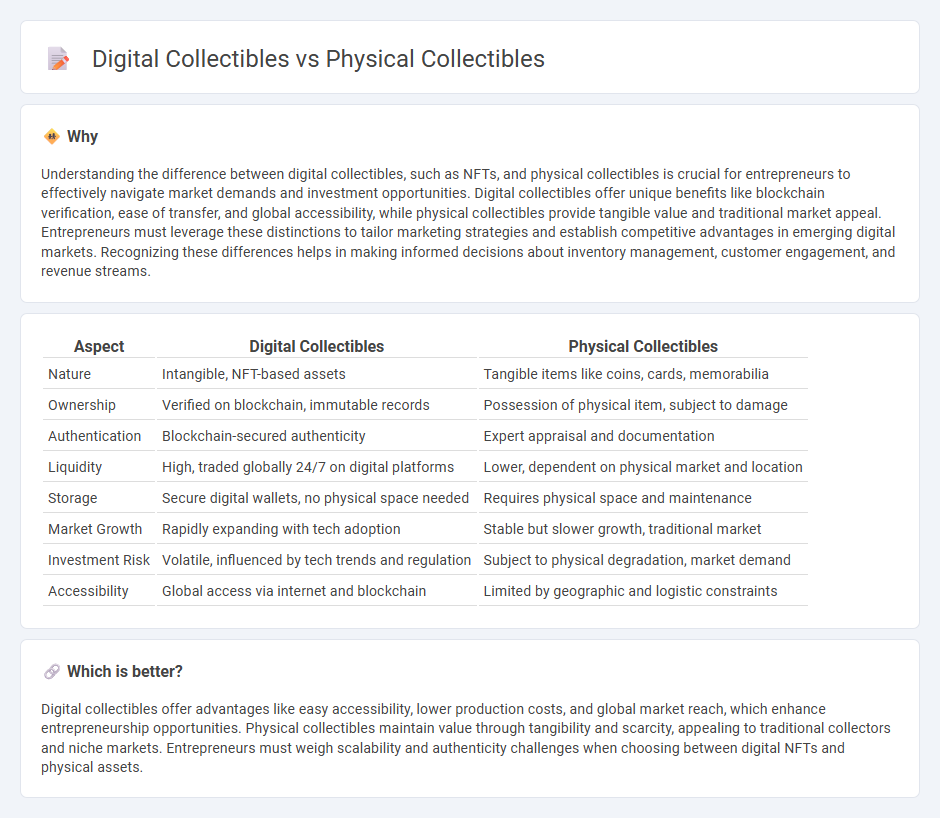
Entrepreneurship in the collectibles market embraces both digital and physical assets, with digital collectibles offering blockchain-backed uniqueness, easy transferability, and global accessibility. Physical collectibles hold tangible value and nostalgia, often appreciated for rarity and condition, attracting traditional collectors. Explore the evolving dynamics between these two forms to understand how entrepreneurial opportunities are reshaping the collectibles landscape.
Why it is important
Understanding the difference between digital collectibles, such as NFTs, and physical collectibles is crucial for entrepreneurs to effectively navigate market demands and investment opportunities. Digital collectibles offer unique benefits like blockchain verification, ease of transfer, and global accessibility, while physical collectibles provide tangible value and traditional market appeal. Entrepreneurs must leverage these distinctions to tailor marketing strategies and establish competitive advantages in emerging digital markets. Recognizing these differences helps in making informed decisions about inventory management, customer engagement, and revenue streams.
Comparison Table
| Aspect | Digital Collectibles | Physical Collectibles |
|---|---|---|
| Nature | Intangible, NFT-based assets | Tangible items like coins, cards, memorabilia |
| Ownership | Verified on blockchain, immutable records | Possession of physical item, subject to damage |
| Authentication | Blockchain-secured authenticity | Expert appraisal and documentation |
| Liquidity | High, traded globally 24/7 on digital platforms | Lower, dependent on physical market and location |
| Storage | Secure digital wallets, no physical space needed | Requires physical space and maintenance |
| Market Growth | Rapidly expanding with tech adoption | Stable but slower growth, traditional market |
| Investment Risk | Volatile, influenced by tech trends and regulation | Subject to physical degradation, market demand |
| Accessibility | Global access via internet and blockchain | Limited by geographic and logistic constraints |
Which is better?
Digital collectibles offer advantages like easy accessibility, lower production costs, and global market reach, which enhance entrepreneurship opportunities. Physical collectibles maintain value through tangibility and scarcity, appealing to traditional collectors and niche markets. Entrepreneurs must weigh scalability and authenticity challenges when choosing between digital NFTs and physical assets.
Connection
Digital collectibles leverage blockchain technology to create unique, verifiable assets that mirror the scarcity and value of physical collectibles such as rare coins or trading cards. Entrepreneurs use digital collectibles to tap into markets driven by nostalgia and exclusivity, bridging physical memorabilia with virtual ownership through platforms like NFTs. This connection enhances customer engagement by combining tangible collectibles' emotional appeal with the accessibility and security of digital assets.
Key Terms
Tangibility
Physical collectibles offer a tangible connection through sensory experience, allowing collectors to touch, see, and often smell items like coins, stamps, or action figures. Digital collectibles, such as NFTs, provide ownership and uniqueness verified through blockchain technology but lack physical presence, relying on digital display and interaction. Explore the evolving landscape of collectibles to understand how tangibility influences value and engagement.
Authenticity
Physical collectibles possess tangible characteristics and often include certificates of authenticity or unique serial numbers to verify provenance, offering a concrete sense of ownership. Digital collectibles, such as NFTs, utilize blockchain technology to ensure an immutable record of authenticity and ownership, preventing duplication and fraud. Explore how authenticity is maintained in both realms to make informed decisions about your collection.
Ownership Rights
Ownership rights for physical collectibles grant tangible possession and direct control, allowing buyers to display, sell, or lend items without intermediaries. Digital collectibles, often secured by blockchain technology, provide verifiable proof of ownership and provenance but rely on platform terms and digital wallets for access and transfer. Explore the evolving landscape of ownership rights in collectibles to understand the distinct advantages and limitations of each format.
Source and External Links
What is phygital collectible? How to make it safe and trustworthy? - Phygital collectibles are physical objects linked to digital assets or experiences, often using NFTs to verify authenticity and combine physical and digital ownership seamlessly.
NFT Insights: Tokenization of Physical Collectibles - EMURGO - Physical collectibles can be tokenized as NFTs to represent ownership, with third-party custody ensuring security, enabling easier trading while preserving provenance and authenticity.
Courtyard: Bringing Billions of Dollars of Physical Collectibles as NFTs - Courtyard offers a platform where physical collectibles like rare cards are securely stored and represented as NFTs, allowing owners to trade digital tokens backed by authenticated real-world items.
 dowidth.com
dowidth.com